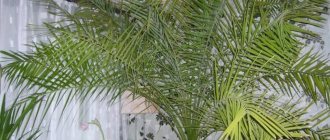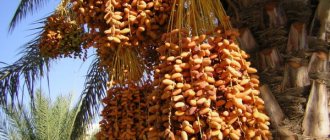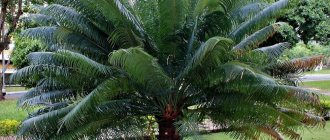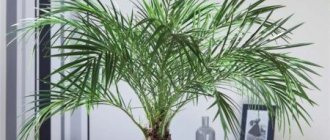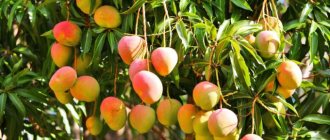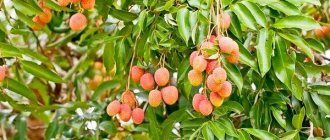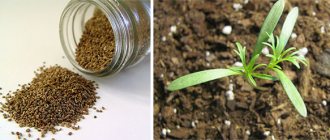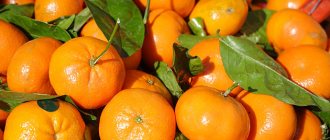Updated: 07.11.2021 14:27:30
Expert: Nikolay Alexandrovich
The date palm is an exotic tree that can increasingly be seen in apartments. The simplest thing is to buy a ready-made tree. But it is not cheap; a change in growing conditions will not have the best effect on the palm tree: it will take a long time to recover after the move. A tree grown from a seed will be adapted from the very beginning to the specific conditions of the apartment. You also need to think about the fact that it will not always be small. Over time, an adult plant up to 2 m high with wide spreading leaves will require a lot of space.
A little biology
According to various sources, the date genus of the palm family contains from 14 to 17 species. But the real date palm, which produces tasty and healthy fruits, is the palmate date. This plant is not found in the wild, which cannot be said about its relatives - 12 species grow in the tropical and subtropical zones of Pakistan and Africa. Over more than 6,000 years of cultivation, the palmate date has been domesticated. By selecting seedlings obtained from sprouted seeds, and then by breeding, about 5,000 varieties have been created. Biological features:
- tall tree - grows up to 30 m with an average trunk diameter of 80 cm;
- the plant is dioecious, the pollen remains viable for a very long time, and is pollinated by the wind;
- the crown of the palm tree has up to 60 feathery leaves up to 6 m long, they are resistant to dust and wind;
- the harsh conditions of deserts and semi-deserts have created endurance - the tree can tolerate both high and fairly low temperatures, the limit is minus 14 degrees;
- lack of moisture has made the date palm drought-resistant; a very deep root system helps the tree to feed on moisture from the lower horizons of the soil;
- it has adapted to the heat: since in direct sunlight the cells responsible for the growth of all organs do not divide, the palm tree grows at night;
- the tree is accustomed to dry air; excess moisture at the time of flowering and fruiting reduces the yield;
- The palm tree is a long-liver; there are cases of trees bearing fruit even at 200 years of age.
When grown in a room, plants are given their usual conditions. A tree of this size, of course, will not grow in an apartment. It most likely will not bloom, and if this happens, there will be no fruit, since a male pollinator tree is required. But even without fruits, the palm tree is surprisingly decorative. But first you need to sow the seeds. They show best germination in the spring.
Temperature
The plant can withstand summer heat above 30 degrees with high humidity. The most comfortable temperature for him, as befits indoor pets, is 23-25 °C.
In winter, the date palm prefers complete rest, so it can withstand 13-14 °C calmly. If there are no conditions for wintering, then the extreme mark for hibernation will be 18 ° C with the condition of more frequent watering.
The plant is not afraid of drafts; moreover, the room in which it stands must be ventilated frequently.
Seed preparation
Growing a date palm or phoenix, as it is called in its homeland, begins with choosing seeds. The plant's habitat is the countries of the Middle East and Africa. But you won’t have to travel that far to get the bones. All you have to do is walk to the nearest store. But not every date is suitable for growing:
- it should not have been subjected to heat treatment;
- stored no longer than a year after collection.
When choosing, pay attention to the size of the fruit - the larger, the better and the absence of signs of disease. If the fruits are dried or candied, this does not prevent their use for growing palm trees.
Since the germination of seeds is unknown, it is better to plant several seeds at once. As soon as the pulp has been removed from them, the seeds are washed from its remnants. A piece of fruit in the soil can rot, involving the seed in the process. Now it needs to be awakened by saturating it with moisture. To speed up swelling, the seeds can be scarified by rubbing them on sandpaper, or immediately soaked for 3 days in water heated to 30 degrees. Its temperature must be maintained constant, which is easiest to do in a thermos. The water is changed several times a day. When they do this for the last time, they add a growth stimulator, diluted according to the instructions. You can immediately sow the seeds into the ground, but you will have to wait a long time for seedlings. The process is easy to speed up if you germinate the seeds:
- soak them between two moistened cotton pads placed in a transparent closed container;
- an alternative is a zip bag with hydrogel or wet sphagnum moss;
- For any germination method, the seeds are placed in a warm (35 degrees) place with diffused light.
The lid of the container or zip bag should be opened daily for ventilation and ensure that the seeds do not dry out. As soon as they hatch, it’s time to sow.
What can grow?
A real date palm can grow from the seeds. True, it will not grow quickly. But speed is not required. After all, a palm tree grown at home will still not bear fruit. But its leaves will become a real decoration of any interior.
Before planting a seed in a pot, you need to know which species should be planted. Otherwise, the seeds may not germinate at all, or there is another extreme - a plant up to 30 meters in height will grow in a pot, and one leaf of such a palm tree can reach 5 meters. Not every gardener will be able to provide such a beauty with warm living space all year round.
Have you tried to grow a date from a seed at home?
Not really
Landing
The choice of container depends on whether the seeds were germinated or not. It is easier to plant the swollen seeds all together in one container and place them in separate pots immediately after germination. Small palms don't need much space when they first start growing. If the seed has already sprouted, it will be better in an individual container. In both cases, there should be drainage at the bottom made of expanded clay or shards. It is important that it covers, but not very tightly, the drainage hole - if fast-growing roots penetrate there, it will be difficult to remove them without loss. And the palm tree has an extremely negative attitude towards their damage.
As a soil, you can use palm substrate from the store, or universal soil will do. Prepare your own planting mixture from 1 part peat and 3 parts sand, adding any baking powder - vermiculite, perlite.
The planting technology is extremely simple:
- prepared soil is poured into a pot with drainage laid at the bottom, not reaching the top by 5 cm;
- cover it with a 4 cm layer of washed coarse sand;
- moisturize;
- place the seed vertically, deepening it by 1 cm, handle the sprouted seeds with special care;
- lightly sprinkle with sand, cover with damp sphagnum moss and place in a bright, warm place (25 degrees).
Now we just have to wait for the shoots. This process is not fast, it takes from one to 3 months, sprouted seeds sprout faster. Sometimes the seed does not wake up for a long time and rises only after a year. All this time, soil moisture must be maintained.
How long does a date grow?
If the seeds were fresh, then you will be able to see the first shoots within a month. Dried seeds will germinate in two to three months.
The date grows for a very long time: feathery leaves appear only after five years. The first two years it resembles grass; the foliage begins to change only in the third year. And in the fourth or fifth year the first dissected shoots appear.
Palm tree conditions
This plant is very unpretentious, but with proper care it grows much better.
Lighting
It is in their homeland that palm trees grow under the scorching sun; in a room such lighting is harmful to them: they require diffused, but quite intense light. In addition, in the hot sun, part of the pot warms up more, this negatively affects the development of the root system. In winter, daylight hours are increased to 12 hours using a phytolamp. In order for the plant to form symmetrically, every two weeks the pot with it is rotated 180 degrees around its axis. The date palm grows best on an eastern window.
Temperature
For comfortable development, a palm tree requires a certain temperature range:
- 20-25 degrees in summer;
- 20 - in winter.
If possible, in the warm season, the pot with the palm tree is taken outside, placing it in the lacy shade of the trees. Soil temperature is also important for the plant. It should not overheat in summer and overcool in winter. To prevent this from happening, the container with the palm tree can be placed in a kind of “thermos” - a pot of larger diameter, the walls and bottom of which are lined with sphagnum moss.
Air humidity
It should not be too high, but dry air is not suitable for the plant. Optimal air humidity is about 50%. If it is lower, the pot with the palm tree is placed on a tray covered with expanded clay, into which water is poured. But the bottom of the pot should not touch it. The plant also needs water treatments:
- for small palm trees, from time to time, when they become dusty, wipe each leaf with a damp sponge;
- for large plants - arrange a warm shower, covering the soil in the pot so that it does not wash out;
- Once or twice a day, spray with soft water at a temperature of 33 degrees, using a fine spray.
In winter, during the heating season, these operations are carried out more often to compensate for the reduced air humidity. The palm tree needs ventilation, but a draft is harmful for it.
Watering
Although the palm tree is a drought-resistant plant, it loves moisture. Water the plant depending on the season:
- in summer - generously 3-4 times a week, not allowing the earthen clod to dry out completely;
- In winter, growth processes slow down, watering is done less frequently - 1-2 times every ten days, drying out the earthen ball almost completely.
When watering, adhere to the rule - the lower the temperature, the less frequent the moisture should be. The next day, it must be followed by shallow loosening of the soil in the pot. Half an hour after moistening, the water is poured out of the pan. For palm trees, the quality of water is very important - it should be soft and at room temperature or slightly higher.
Feeding
You need to actively feed the palm tree in spring and summer, using fertilizer intended specifically for this species or complex soluble mixtures for decorative deciduous plants. Battery ratio: N:P:K-3:1:3. Root feeding is carried out after watering with clean water once every 2 weeks, foliar feeding - with the same composition, but diluted 10 times monthly. In winter, 1 feeding per month is enough.
If a palm tree lacks micro or macroelements, this is reflected in its appearance:
- light green leaves with stunted growth indicate nitrogen deficiency;
- bronze-brown spots on the leaves, first old and then young - a signal of potassium deficiency;
- a wide strip of yellow color forms along the edges of the green leaf - the palm tree does not have enough magnesium;
- Sometimes at the initial stage of growth, young palm trees do not have enough manganese, in which case they grow poorly and chlorosis appears on the leaves.
The easiest way to eliminate a deficiency of some element is with the help of foliar feeding.
Species that can be planted at home
Breeders have been interested in growing dates for a long time.
To date, a huge variety of date palm varieties have been bred - more than 1000 species.
Many of them bear fruit, many types of palm trees whose fruits are inedible, but only three types are suitable for growing at home:
Canary palm
The palm tree, which grows into a single trunk, has very small inedible orange fruits. If not limited in height, it can grow up to 15 meters in height. This is exactly the height she grows in her homeland, the Canary Islands. There it has huge leaves - 5 meters long. But at home the palm tree does not reach such a size. And it grows very slowly. But it adapts best to growing in pots. It endures all unfavorable conditions and delights its owners with the bright greenery of beautiful leaves, strong stems and exotic appearance.
palmate palm
Without limitation, it grows up to 15-20 meters. It can be grown from an ordinary date, because its fruits are sold in stores. She is growing much faster than the others. In its homeland, in southern Africa, Spain and Asia, it produces delicious fruits. At home, the fruits will not be able to ripen, however, it will be great at adding a touch of exoticism to your home design.
Robelena palm
is native to India. This beauty does not grow too tall, only up to 2 meters. It has several trunks, thin trunks. The fruits are black and small. The leaves are wide and decorative. This is the most beautiful palm tree that you can grow at home. True, it is more suitable for greenhouses, because even a small height for palm trees - 2 meters - requires space.
But if you really want to plant a palm tree and are not afraid of everyday difficulties, then you can start growing it.
Transfer
Young date palms need annual replanting, the first one is done as soon as shoots appear. The best time to move to a new pot is the beginning of active growing season, usually April. Starting from 5 years old, you can replant after a year, and in adult plants you can simply change the top layer of soil. When pouring water from the tray after watering, inspect the bottom of the pot - if the roots begin to invade the drainage holes, it’s time to replant the date.
The soil
The easiest way is to buy ready-made substrate for palm trees. The plant feels good in a substrate prepared from an equal amount of sand, humus, grain soil, and compost. For every 3 liters of mixture add a tablespoon of superphosphate. Adding a small amount of perlite and 1cm pieces of charcoal will make the soil looser. You can prepare a more nutritious mixture:
- 2 parts clay turf soil;
- the same amount of leaf humus;
- 1 part each of peat, sand and rotted manure;
- some charcoal.
If, during transplantation, the composition of the soil is suddenly changed, even in the direction of improvement, this will negatively affect the plant.
Pot
The peculiarity of the date is that the roots grow deep and not to the sides. This determines the choice of pot: it should be tall and not too wide. With each transplant, choose a pot 3-4 cm larger than the previous one, this applies to both height and diameter. The material is plastic; it is easier to remove the plant from such a pot for replanting; if necessary, it can be cut. Roots in plastic dishes suffer less from temperature changes.
Transplant algorithm
In order not to injure the roots of the plant, it is simply transferred to a new container, preserving the earthen lump as much as possible:
- the date is watered on the eve of transplantation;
- drainage from washed expanded clay is laid at the bottom of the new pot - a quarter of the height or a little less;
- pour a small layer of planting mixture on top;
- knead the walls of the old pot to make it easier to remove the plant;
- place the date in a new pot so that the root collar is not buried;
- all voids are filled with the prepared planting mixture, slightly compacting it;
- the soil is watered.
The first feeding is carried out no earlier than after 2 months. If the roots are accidentally damaged during transplantation, you need to cut off 1-2 lower leaves of the plant.
Choosing a pot
The peculiarities of the date palm are such that in the first stages the root grows at an accelerated pace . The date has a tap root system, that is, one root is the main root, the rest are subordinate.
For such a plant, try to choose a pot that is deep and narrow so that the date feels comfortable.
Initially, all seeds can be planted in one deep box.
Dates cannot tolerate stagnant moisture, so be sure to add a layer of drainage , which can be expanded clay, broken brick, pebbles or charcoal.
Diseases and pests
If the plant was placed outside in the summer, most likely pests have already appeared on it. From time to time they appear on those palm trees that are constantly in the room. The following are dangerous for plants:
- mealybugs
- they suck the juice from the leaves, first settle in their axils, then spread to the entire plant, including the root system; insects are white with a large number of legs and a waxy coating similar to cotton wool on the body; the honeydew they secrete is an excellent breeding ground for sooty fungus; Mealybugs prefer low air humidity;
- spider mites
first appear on the stems of palm trees, then colonize their leaves, sucking cell sap from them; mites are very mobile and easily move from flower to flower; their sizes are small, it is difficult to see a spider mite with the naked eye, but traces of its vital activity are clearly visible - puncture sites on the leaves, especially from the inside; if a colony of mites has woven a web on the underside of a leaf blade, several generations of pests have already lived in it; ticks love dry air and low temperatures;
- thrips
- small mobile insects with an elongated body, lay eggs directly into the tissue of the leaf blade, thrips can be found on the underside of the leaf along the veins, where brownish-brown spots appear; on the front side they look whitish;
- scale insects
— the first instar larvae, covered with a waxy shield, are dangerous for palm trees; they look like small brown-golden or whitish growths; attaching to the leaf, they suck out its juices; red-brown or yellowish spots are noticeable at the site of the lesion;
- aphid
often appears on plants that were taken outside in the summer, sometimes it enters the apartment through the window during ventilation; the small oval body of the sucking insect is colored green, black, orange or gray, the aphids seem to merge with the stem and leaves; you can guess its presence by the honeydew that the insect secretes;
- nematode
- the pest lives in the soil or on various parts of plants - these are tiny worms that cause great harm to palm trees: at the site of damage, first yellowish and then brown spots form, which turn black over time, the leaf dies.
How to fight
If the number of pests is small, you can try traditional methods of getting rid of them:
- leave 15 g of chopped onion in a liter of water under a lid for 5-7 hours, strain, spray;
- Grind 20-30 g of dandelion roots and leave in a liter of warm water for 2 hours - solution for spraying;
- Grind 50 g of fresh hot pepper and boil in 0.5 liters of water, spray after cooling and straining;
- Gently wiping the leaves with medical alcohol is effective; after 5 minutes the plant is given a warm shower, protecting the soil in the pot from getting wet.
Some pests - scale insects and scale insects - are collected by hand using a cotton pad or a hard brush moistened with soapy water.
If these measures do not help, use insecticides and insectoacaricides
, approved for indoor use: “Fitoverm”, “Lepidotsid”, “Bitoxibacillin”, “Aktaru”.
Works well against spider mites
"Bitoxibacillin", "Apollo", "Akarin", "Flumite". Preparations with a higher hazard class are used to treat palm trees, taking them out into the open air. For better efficiency, place a plastic bag on the pot with the palm tree and tie it tightly. It is not removed for 2 days; all this time the plant should be in the shade. The fight against spider mites does not end with treating the palm tree. It needs the soil, the outer part of the pot, all nearby plants, the windowsill and window glass - the pest can lay eggs far from its habitat.
Prevention
Palma loves water treatments. If you do them regularly, protecting the soil in the pot from getting wet, most pests, with the exception of scale insects, are simply washed away. Washing the leaves with soapy water is more effective. Spider mites can be destroyed by irradiating the palm tree with ultraviolet light twice a week for 2-3 minutes using a special lamp. It should also illuminate the lower part of the leaves.
If a nematode is found on a palm tree, the plant cannot be helped.
Diseases
The cause of most palm diseases is improper care. Before starting treatment, it needs to be adjusted. Most plant diseases are caused by fungi:
- root rot is caused by a fungus of the genus Fusarium
; the leaves turn yellow, then darken and wither; when inspecting the roots, areas of rot with an unpleasant odor are discovered; You can help a palm tree only at the beginning of the disease: the roots are washed with water, all rotten parts are cut off, washed with a solution of fungicides - “Kuprozan”, “Khometsina”, and the cuts are treated with crushed coal;
- if dark spots appear on young plant tissues
, and then a white coating - a fungus of the genus Penicillium is to blame; spraying with a solution of copper sulfate will be required;
- The causative agents of leaf spot are fungi of the genera Rhizoctonia and Pythium
; The disease manifests itself as rot of the base of the leaf; if it is not treated, the palm tree may be left completely without a crown; spraying with Bordeaux mixture will help;
- Pink rot affects weakened plants
, especially if they were cut with a non-sterile instrument, rotting begins on the leaves, in advanced cases it can spread to the tree trunk, treatment is removal of diseased parts, treatment with fungicide solutions.
Problems during cultivation
As a rule, they are associated with disruption of care:
- brown spots on the leaves when growth is stunted - the plants are overwatered or the water is too hard;
- the tips of the leaves dry out and turn brown - low air humidity, lack of water, low temperature;
- the lower leaves dry out and turn brown - they have already outlived their useful life and need to be cut;
- leaves turn yellow - there is not enough moisture or nutrition;
- if the palm tree is not constantly topped up, the lower leaves may hang, the plant will lose its decorative effect, they will no longer be able to rise, they will have to be tied up;
- poor growth - too low a temperature in summer, high acidity of the soil, lack of nutrition, cramped pot;
- pale spots on the leaves are burn marks; the palm tree needs shading from direct sunlight.
If the leaves of the entire plant turn brown, the root system is rotting due to excessive moisture. If the damage is severe, the plant will die. Sometimes novice gardeners are perplexed by the structure of the leaves of a young palm tree - they grow narrow and do not fan out. This phenomenon is temporary and is associated with the age of the plant; usually by the age of five the crown takes on a standard appearance. Good care and annual transfer to a new pot will speed up the process.
